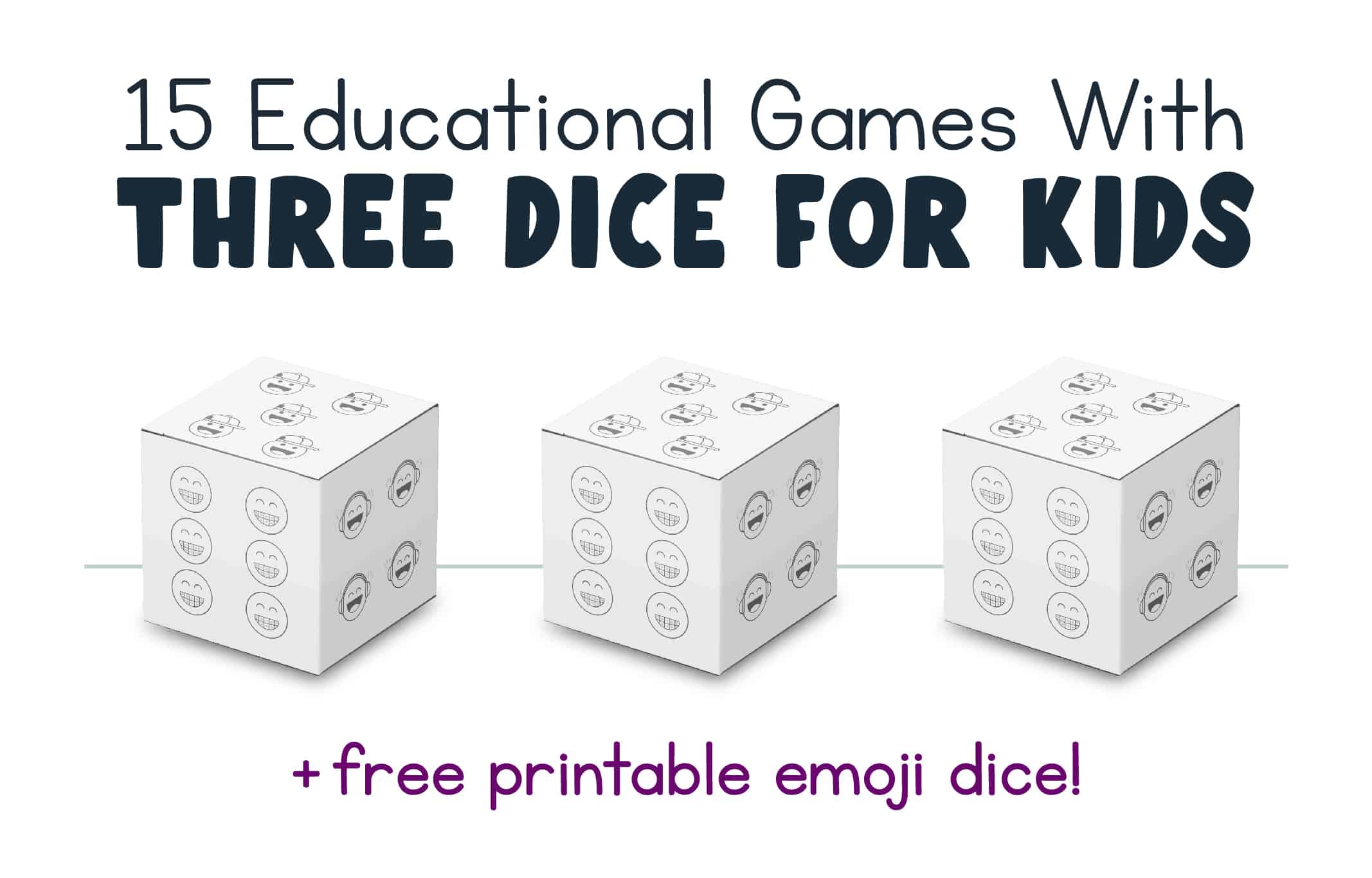15 Educational Games With Three Dice for Kids (+ FREE Printable Dice)
It can be tough to keep kids entertained, energized, and engaged in activities, but with games that use three dice, you can achieve all of those goals at the same time, and more!
I use fun dice games in my classroom because they require skills such as problem-solving, strategy, movement, and a bit of healthy competition. My students build a variety of skills while having a blast playing and learning.
While many common dice games use one or two dice to play, I like to take things up a notch with my upper elementary students and explore activities that use three dice as a way to practice different skills across the curriculum. Exciting!
In this blog you’ll find three categories of dice games using three dice:
🔢 1-5 Math Games
💬 6-10 Language Games
🏃♀️ 11-15 Physical Education Games
Within each category, we’ve included directions, images, and even suggestions to level up the games and make them even more exciting to play.
There’s definitely something for everyone to enjoy here.
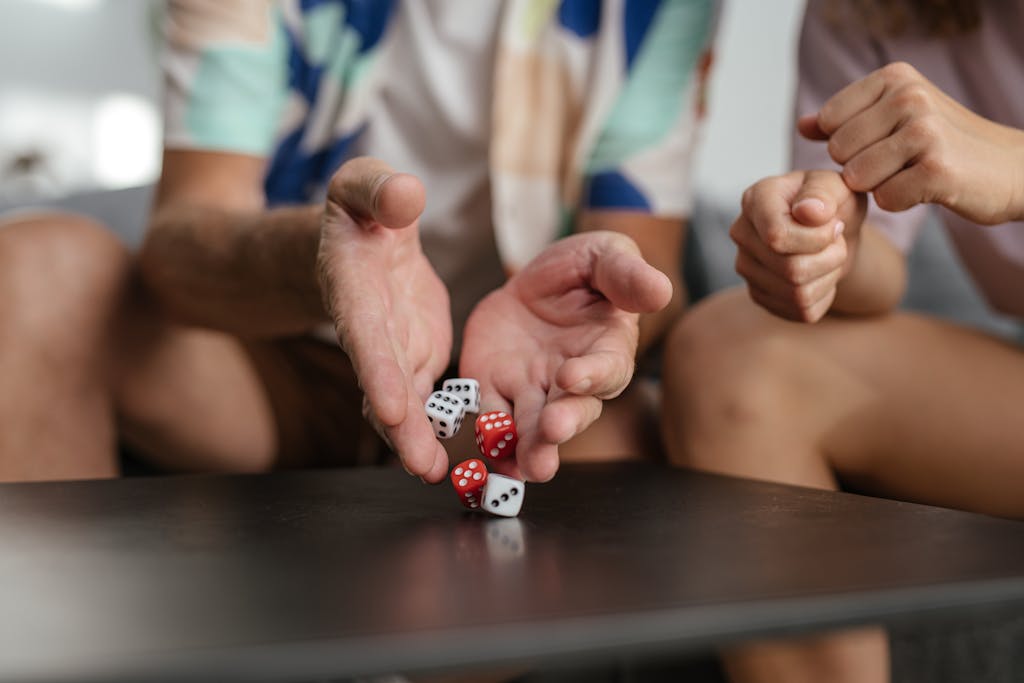
What Are Dice Games?
Dice games are a type of activity where one or more dice are used as the sole or central component of the game.
Games with dice can be used for a wide range of purposes, including teaching math concepts, practicing motor skills, as well as providing entertainment.
Kids love easy dice games because they offer opportunities to be social, think outside of the box, explore boundaries, and expand their knowledge. Plus there’s that element of luck and not knowing what the dice are going to land on. That’s always fun!
These are all things the inquisitive minds of the elementary child in the second plane of development are searching for.
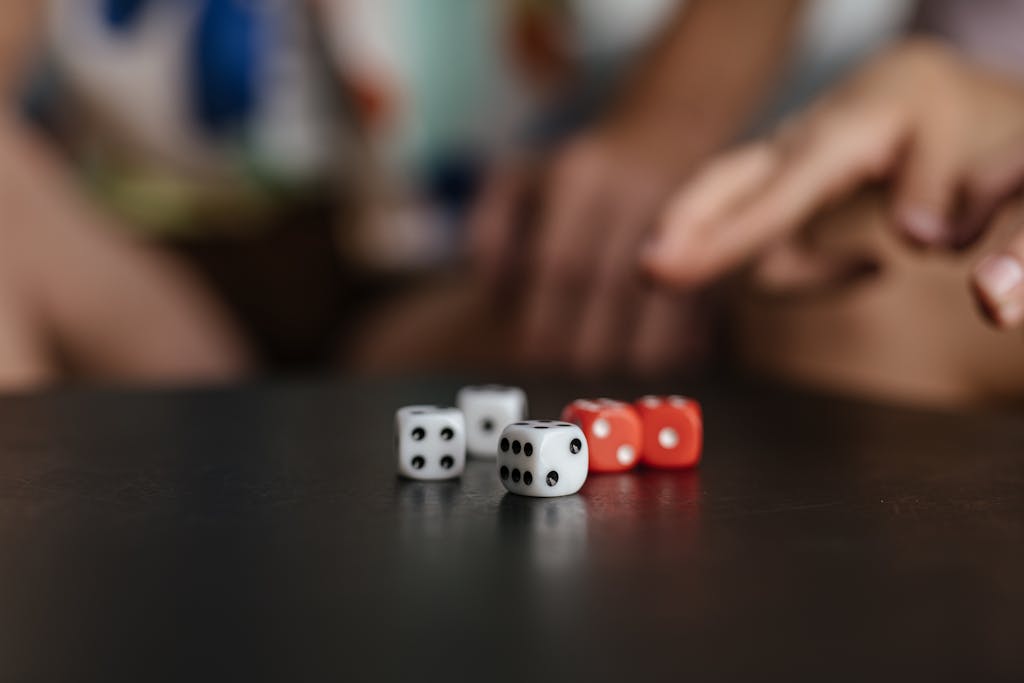
15 Educational Games Played With Three Dice
The games outlined below are all played using three dice and are student favourites in my upper elementary classroom.
They are perfect for kids of all ages but resonate really well with students in grades 4, 5, and 6. Many of these games are also great for the middle school level.
Not only are these dice games easy to learn, but they also provide hours of entertainment.
So let’s get to that list already!
The categories included are:
🔢 5 Math Games
💬 5 Language Games
🏃♀️ 5 Physical Education Games
☝️ Click any of these 3 links above to you’ll go directly to that section.
💡Don’t have dice? Don’t worry!
Read to the end to get your FREE printable emoji dice (includes a blank net of a cube template, too!). My students love colouring, cutting, building, and playing with these dice. It’s quite the hands-on learning experience.
Or You Can Use Digital Dice
I use this website in my in-person and virtual classroom settings.
You can roll one dice at a time, or click the setting icon (the gear in the bottom right corner) to choose how many dice you’d like to use.
Math Games with Three Dice
Games with dice can help teach kids important math skills in a fun way. Before getting into these games, I always have players gather paper and a pencil to do some math work and keep track of scores.
1. Beat That
😀 Players: 2 players
📝 Materials: Paper and pencil for each player
🔢 Working: Number Sense, Problem-Solving, Less Than/Greater Than
🎯 Objective: Build the largest 3-digit number.
😎 Ages: 6 – 12 years
🎲 Dice: 3 dice for the whole group (or use one die and roll it three times)
How to play:
On their turn, children toss all three dice and have to come up with the largest three-digit number possible by arranging the dice rolled.
Next, that player would pass the three dice to the next player with the invitation, ‘Beat That!’
At the end of each round players compare numbers and decide whose number is the largest. The player with the largest number wins the round and gets one point.
For example:
If a player rolls three dice and the numbers are 4, 6, and 3, then the highest number they can make using those numbers would be 643. The player would write that number down on their paper and compare it to their opponent.
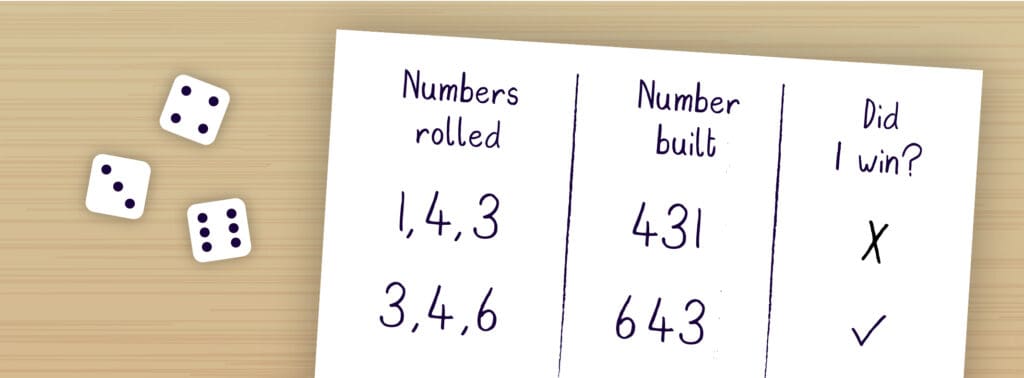
How to win at Beat That:
Children can play for a predetermined amount of rounds or points. A winner is declared at the end of each round and 1 point is awarded. I like to play for six rounds or the first to six points.
The player who wins the most rounds, and consequently has the most points, wins the game.
Pair this game with a lesson on greater than, less than, or equal to, and watch your young learners flourish. It’s worth trying!
✨🎲 🎲 🎲✨
Level Up This Game!
Try these ideas for a challenging extension of this game:
🔹 Take it up a notch:
At the end of the game, have players add up all of the three-digit numbers they have recorded, and see who has the largest sum.
🔹 For more experienced players:
Have players turn their three rolled numbers into an order of operations equation using a combination of addition and multiplication. Students will roll one die at a time, and in that order fill a predetermined math equation. This will really get them thinking mathematically and comparing numbers in many ways.
🎲 For example:
If your student rolls a 4, 6, and 3 in that order the player can form the questions:
➜ 4 + 6 x 3 for a total of 22 (a + b x c)
➜ 4 x 6 + 3 for a total of 27 (a x b + c)
Working through equations gets them really practicing an assortment of math skills.
Whoever has the highest total gets a point for that round.
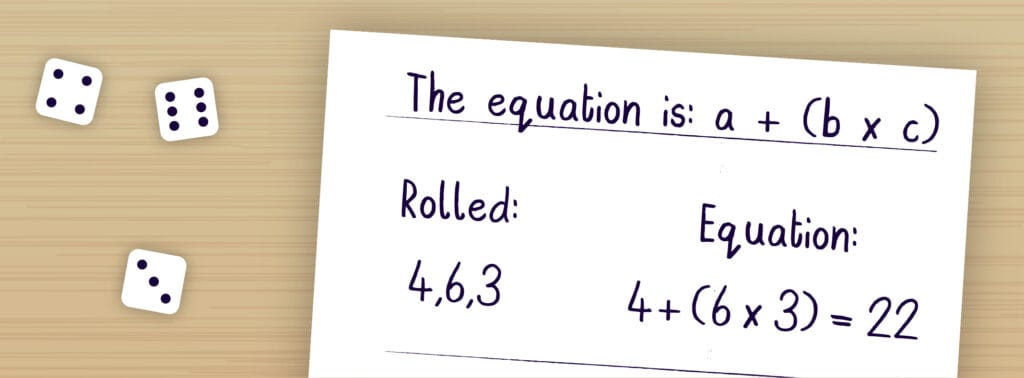
🔹 Have some really advanced students?
Get students to use their three numbers rolled in math equations that include a combination of subtraction and division! The goal of this version of the game would be to have the smallest answer. Fun!
2. Time to Get to Ten
Use this quick-thinking, mental math, on-your-toes game as a warm-up activity for your next math lesson. Your students’ attention will be drawn!
I use this activity to get my students to practice their addition skills in a fun way. It’s also a wonderful way to fill a few minutes with productive learning. I even use this activity with my upper elementary students during indoor recess.
😀 Players: 4 or more players
📝 Materials: Timer, Paper, and pencil for each player
🔢 Working: Addition and Mental Math
🎯 Objective: Roll a sum of ten, or close to it without going over.
😎 Ages: 6 – 12 years
🎲 Dice: 3 dice for the whole group (or use one die and roll it three times)
Before you begin:
Set a specific amount of time to play this game. I like to start with ten minutes, but you can adjust the time to fit your schedule and the needs of your students.
💡 Don’t have a timer?
Did you know you could type ‘10 minute timer‘ (or any desired amount of time) into Google, hit enter, and it will start counting down the time for you right away? My students love this handy tool!
There are also websites like this one that allow you to set up kid-friendly timers with fun animations.
👇 Alternatively, you can just hit play on this ten minute timer here: 👇
OR
Don’t use a timer at all!
🔢 You could play the game for a specific number of rounds.
OR
Have players keep a running sum of their numbers rolled.
🧮 The first person to reach 100 points ends the game!
How to play:
🎲 Players take turns rolling all three dice and writing down the numbers they rolled.
➕ After rolling and writing down their 3 numbers, they add the numbers rolled together.
🏆 The goal of each roll is to get as close as possible to a sum of 10, without going over.
For example:
➜ If a player rolls 3, 4, 1 the sum would be 8. A great score!
➜ But if they would have rolled 3, 4, and 5 it would make a sum of 12, an unfavourable outcome.
➜ BONUS ROLL: If two of the same number are rolled (doubles), that player gets to have another roll of all three dice again, and they can use any 3 of those 6 numbers rolled to get their sum closest to ten for that round.
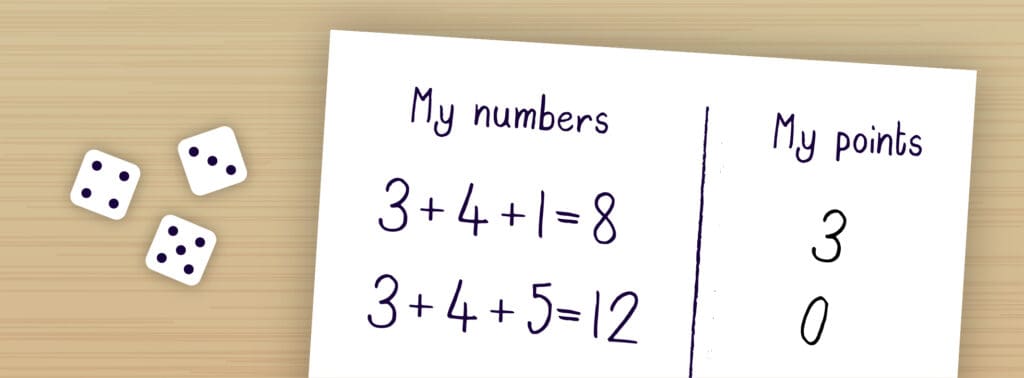
How to score points in this game:
🔟 If a player makes ten perfectly when adding all three numbers together, they score 10 points.
5️⃣ The player who gets closest to ten without going over receives 5 points.
3️⃣ The player who is the next closest to ten without going over gets 3 points.
1️⃣ And the next closest to ten without going over after that collects 1 point.
0️⃣ Every other player as well as players who go over ten get a score of zero for the round.
⏰ The player with the most points when the timer goes off wins!
➜ More than one player can receive the same amount of points in a round. For instance, if one player rolled a sum of ten they get 5 points, but if three players rolled sums of 9, they would each receive 5 points for that round.
💡Level Up This Game!
Bring BEDMAS to life with this activity:
Have students explore the order of operations with the three numbers they rolled and have them use any of the four operations (addition, subtraction, multiplication, division) to get an answer that is ten or as close to ten as possible.
For example:
➜ Let’s say a student rolls a 3, 2, and 6. They may want to arrange those numbers into the following equation: 2 x 6 – 3 = 9 That’s pretty close to ten!
Need a refresher on BEDMAS?
Check out the Order of Operations Task Card and Anchor Chart we created!
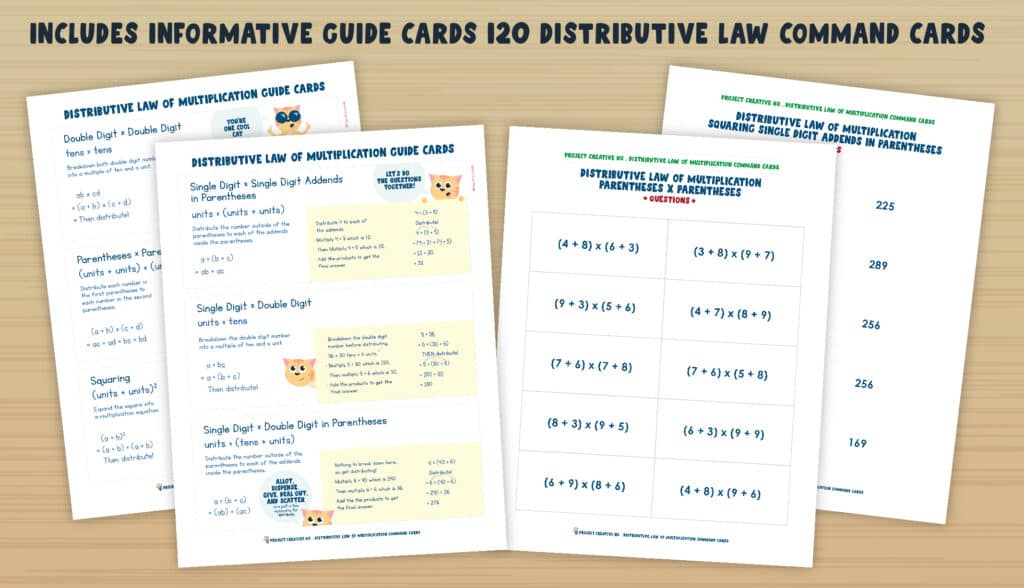
3. Going Somewhere?
Students are always excited when they get to go somewhere, right? This game combines the skill of adding with the concept of distance to bring a whole lot of fun to learning.
😀 Players: 2 to 6 players
📝 Materials: Map, Atlas, or Google Maps, Paper and pencil for each player
🔢 Working: Addition, Distance, Geography
🎯 Objective: Be the first to arrive at the travel destination.
😎 Ages: 6 – 12 years
🎲 Dice: 3 dice for the whole group (or use one die and roll it three times)
To begin:
📍 Pick a destination – somewhere that is over one hundred kilometers or one hundred miles (are you using the metric of imperial measurement system?) from where you are, is an interesting place, and maybe even somewhere you’ve been studying in class.
🗺️ When the desired location has been selected, have learners do some research to find out the exact distance in kilometers or miles from their origin to the selected destination.
Then, it’s time to get rolling.
🎲 Have players take turns rolling three dice, and adding the numbers rolled together to get their distance traveled for that round.

For example:
If a player rolls 3, 5, and 2 in one round, then they have traveled 10 kilometers (or miles) in that round (3 + 5 + 2 = 10).
🏆 The player that passes the distance to the chosen destination first wins and gets to choose the next travel destination. Fun!
💡Level Up This Game!
To make this game more challenging, choose a location that is far away, like really far away. Somewhere that is over 5,000 kilometers or miles distance from you.
And then have students multiply their three numbers rolled to get one large product. How long will it take them to roll their way to each destination????
✨✨✨
Why Not Integrate Some Cross-Curricular Learning
Have students do some research on the places they have mathematically traveled to. Where in the world is it located? How big is it in land size and population? What’s the weather like there? What do they import and export?
Connecting Math and Geography in one fun game. Isn’t that something?
✨✨✨
🌕 FUN FACT! The moon is 238,900 miles away from the earth?
Why not connect math with science and see how long it takes to roll their way to the moon, Mars, or even Jupiter? The universe holds an abundance of learning opportunities!
4. Going to Town
Going to Town, also known as Going to Boston (but you can name it anything you like!), is another simple yet exciting dice game. My upper elementary students take it upon themselves to play this game any chance they get.
😀 Players: 2 to 4 players
📝 Materials: Paper and pencil for each player
🔢 Working: Adding and Number Sense
🎯 Objective: Win the most rounds by rolling the highest total dice amount each round.
😎 Ages: 8 – 12 years
🎲 Dice: 3 dice for the whole group
The goal of Going to Town is to win the most rounds by rolling the highest total dice amount.
To start:
✔️ Mutually agree on how many rounds you’d like to play. I like to play five rounds OR play for a specific amount of time and make it about going as fast as possible.
✔️ Decide who will roll all three dice first by having each player roll one die to see who rolls the highest number. They get to start the game.
To play:
🎲 🎲 🎲 The first player will roll all three dice at once. From the three dice rolled, the player will keep the die with the highest number and set it aside.
🎲 🎲 The same player will then roll the remaining two dice and again hold onto the die with the highest number.
🎲 The player then rolls the final dice and keeps that as their third number.
➕ The player’s score is the total of the three dice rolled and kept. Make sure they record their numbers rolled and their scores!
🔁 These steps will be repeated by each player around the table.
🏅Once everyone has rolled, the player with the highest score wins that round.
🏆 The player who has won the most rounds will walk away victorious!
🤓 If this is too easy for your students, be sure to try our suggestion below.
Here’s a video demonstrating how to play this dice game:
💡 Want to make this game harder? Include multiplication!
Have players either:
🔹 Multiply all three numbers they rolled together to get their score for the round.
OR
🔹 Add or multiply the first two numbers, and then multiply or add that sum or product by their third number.

Calculating the score of dice rolled can look like this:
R1 = Roll 1 • R2 = Roll 2 • R3 = Roll 3
R1 + R2 + R3 = score for the round
(R1 x R2) x R3 = score for the round
(R1 + R2) x (R3) = score for the round
or
(R1 x R2) + (R3) = score for the round
5. Dice Collectors
Dice Collectors is a fun dice game of chance that students of all ages can get into making it a great math center activity.
Introduce this easy dice game to your students and see how interested they become in math!
😀 Players: 2 to 4 players (each player needs three or more dice)
📝 Materials: Paper and pencil for each player
🔢 Working: Number Sense and Greater Than/Less Than
🎯 Objective: Collect the most dice by rolling high numbers.
😎 Ages: 8 – 12 years
🎲 Dice: Each player needs three (or more) dice. If you have more dice available to you, try this game with more dice and see what works for your students!
⭐🎲⭐ Don’t have enough dice? Download our FREE printable!⭐🎲⭐
To start a round:
👋 At the same time, all players roll one of their three dice.
🥇 The highest number rolled is the winner of the round.
🎲 The person that rolled the highest number gets to keep all the dice rolled in that round.
2️⃣ Next, everyone rolls again at the same time to start round two, and the process is repeated.
🚫 When a player runs out of dice they are out.
👔 If there is a tie in a round, then that round is declared a draw. Everyone collects their dice rolled and everyone simply rolls again. OR, have the two players that rolled the same numbers roll again to declare a winner for that round.
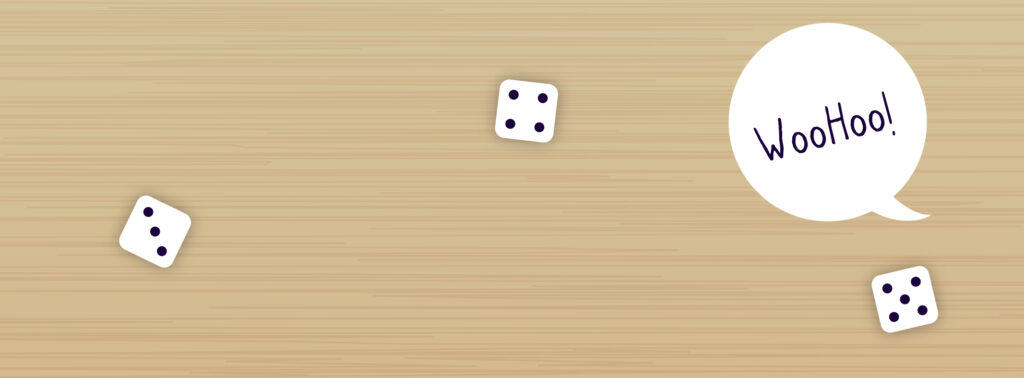
💡Double the challenge with more numbers!
The rules are the same but the gameplay alters slightly.
To start a round:
👋 All players roll just one of their three dice, but they roll it twice!
➕ Now they add the two numbers rolled and hope for the largest sum.
✖️ You can also try this with multiplication by having players multiply their two numbers rolled to see who has the largest product.
✨🎲 🎲 🎲✨
💡 Discover more math activities for elementary students:
Math Made Easy: 9 Montessori Command Card Benefits
35 Money Books for Kids that Teach Financial Literacy
21 Fun Math Games with Dice for Kids 8-12 and FREE Printable Dice
Math Activities for Kids: Explore 9 Montessori-Aligned Ideas
25 Math Board Games Kids Love and Teachers Approve!
Language Games with Three Dice
Dice games are not just for math class! Check out these five fun and easy language games that use three dice for gameplay.
6. Roll a Story
Using dice that have pictures on them is a fun way to develop story-writing skills in elementary students.
In Roll a Story, children roll a variety of dice with story element images on each side of every cube to create a prompt for an epic story that they will write.
For this writing activity, it’s important to have dice with images on all six sides of the cube. Picture dice are great because they provide a clear and interesting visual for children.
😀 Players: 1 to 8 players
📝 Materials: Paper and pencil for each player
🔢 Working: Story Writing and Creative Writing
🎯 Objective: Build story writing skills using images rolled to write a fiction story.
😎 Ages: 6 – 12 years
🎲 Dice: 3 (or more) specialized dice with images on them.
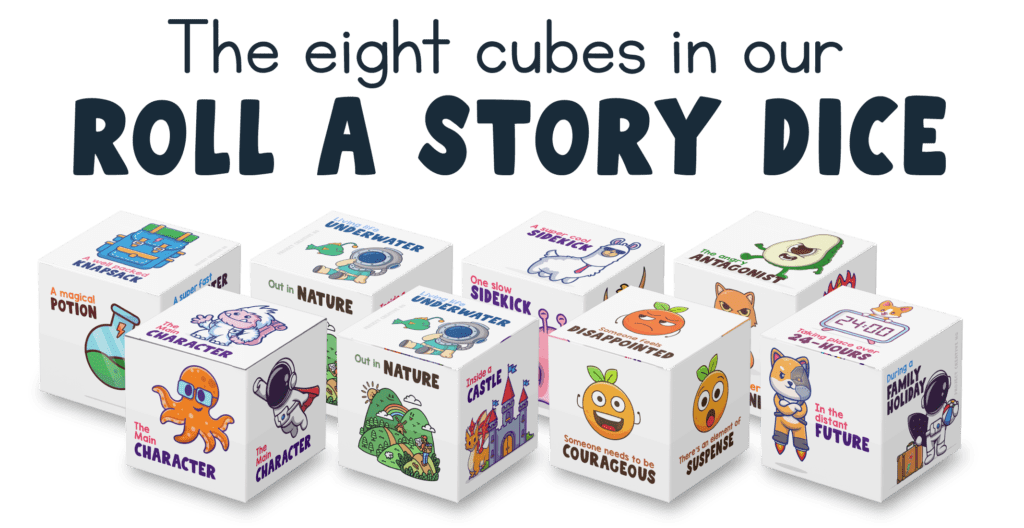
Don’t have dice with images?
I’ve used the classic Rory’s Story Cubes with my students, my stepdaughter, as well as with my nieces and nephews, and they always enjoy creating stories with them.
While these dice are good, they don’t offer the story-building structure I was looking for. I was in need of a tool that helps students understand and develop various story elements, guiding them through the writing process and organizing their thoughts.
When you can’t find what you need, you make it yourself! In my case, I enlisted the help of my super-talented partner, an amazing graphic designer.
And that’s the story behind our Roll A Story, an awesome story-writing activity that is eye-catching, colourful, and filled with interesting characters and details that will inspire elementary-aged students.
You could even download our FREE dice printable and use the blank page provided to make your own Roll a Story dice.
To start:
🎲 One player rolls three (or more) dice with images on them.
✏️ They write down (or draw!) all the images they rolled.
🎲 The next player in turn will roll their dice.
✏️ Then that player will write down (or draw!) all the images they rolled.
🔄 Continue until all players have rolled all three (or more) of their dice and have their images noted.
Once all players have rolled their three (or more) dice:
⏰ Set a timer and have participants independently write a story using the images that they rolled. Typically I give 25-30 minutes for them to turn their images rolled into a story. Sometimes I only give them 15 minutes if I feel like really testing their focus and quick thinking.
⏰ After the timer goes off, students will regroup and share their awesome stories out loud.
⏰ This is great practice for pacing their story writing if they plan to take the SSAT examination.
The story can be as long or as short as they like, but it has to have a clear:
1️⃣ Beginning
2️⃣ Middle and
3️⃣ End

While there is no winner in this game, it’s a great activity for developing language skills, creativity, as well as presentation skills, and that’s a win in our books.
It’s also a lot of fun and boosts creativity!
🎲 Take this activity a step further with these fun extension ideas:
➡️ Have participants create a movie poster for their story.
➡️ Have students work together in small groups to create one detailed tale by combining all of their rolled images.
➡️ Have story writers turn their tales into comic strips.
Check out our blog 11 Ways to Use Roll a Story Dice Game for more ways to use these cubes.
7. Roll a Question
Roll a Question is a fun way to get children talking and expressing themselves clearly and confidently. It is also a great activity for developing communication skills and learning how to carry a conversation politely.
😀 Players: 2 to 8 players split into two small groups
📝 Materials: Timer, List of 15 Questions (numbered 3 to 18), Paper, Pencil
🔢 Working: Conversational Skills, Addition
🎯 Objective: Get students to speak and build social skills by learning to carry a conversation.
😎 Ages: 9 – 12 years
🎲 Dice: 3 dice for the whole group
To play:
🧐 As a group, make a list of 15 conversation-sparking questions and number them from 3 to 18. We have 6 questions listed below for reference!
⭕ Have students sit in a circle.
🎲 One player rolls all three dice.
➕ The player then adds the numbers rolled together. Yay math!
💬 Whatever their sum is will be the question number that they will ask the player to their left.
Let’s look at an example:
If a player rolls a 1, 3, and 1 they would first have to find the sum of those three numbers, which is 5.
Next, the students will reference the chart of 15 prepared questions and ask the player to their left question number 5.
The questions on the list can be about anything really. They just need to spark conversation.
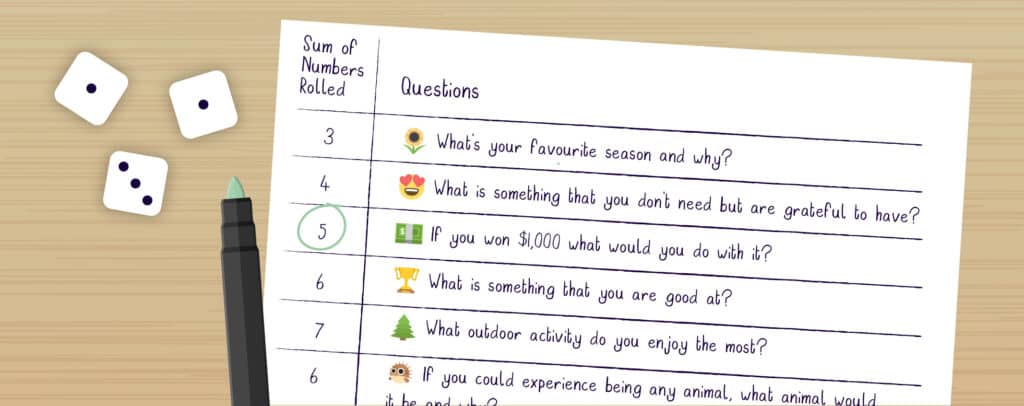
Some of my favourite questions to include on the list of 15 are:
☀️ What’s your favourite season and why?
😍 What is something that you don’t need but are grateful to have?
💵 If you won $1,000 what would you do with it?
🏆 What is something that you are good at?
🌲 What outdoor activity do you enjoy the most?
🦘 If you could experience being any animal, what animal would it be and why?
✴️ REMEMBER: Since we are using three dice for this game, your list of 15 questions should be numbered 3 to 18 because it is not possible to roll anything lower than a sum of 3 with three dice.
But here’s the catch and how players score points:
📢 Players are required to engage in conversation about the question they rolled with the person to their left for 90 seconds.
5️⃣ If they make it to 90 seconds the player who rolled the dice gets 5 points and their partner in conversation receives 3 points.
1️⃣ If the conversation fades before 90 seconds, or they take the conversation off topic each player only receives 1 point.
As you can see, there is motivation on both parts to keep that conversation going and going, and on topic!
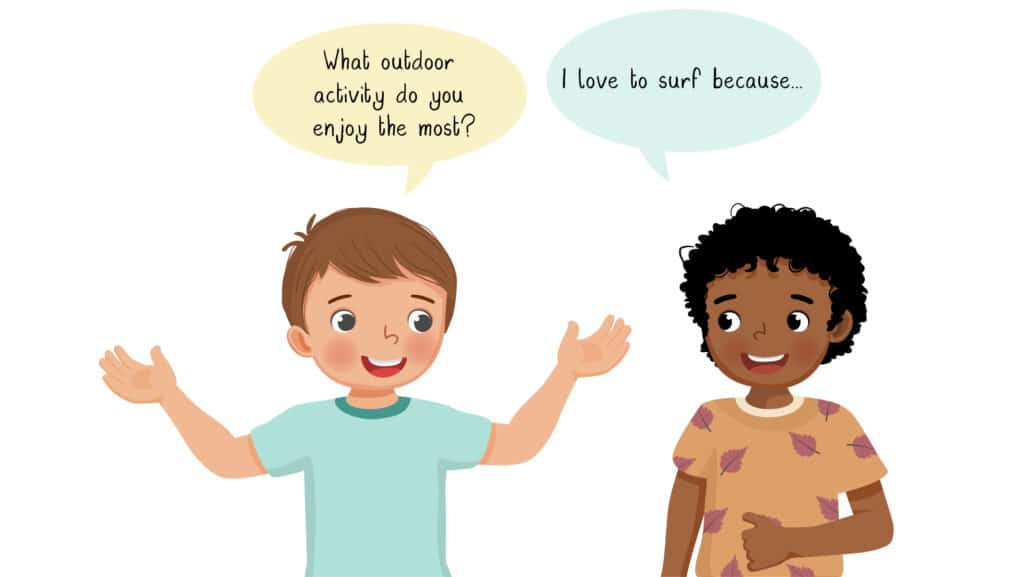
💡 Have a chatty group? Then get them conversing longer!
Up the conversation time to 120 seconds or even 240 seconds.
You know elementary students, once they get started talking you wonder if they will ever stop!
💡 We have a question for you!
Are you using math games with dice with your elementary learners?
If you’re not, you should be!
Regardless of if you are or if you’re not, it’s certain you’ll love this blog:
21 Fun Math Games with Dice to Try With Kids 8-12 (+ FREE Printable Dice)
8. Alphabet Assignment
Math and language come together here for some powerful and fun learning in this engaging and easy dice game. A sure hit for any elementary learning environment.
😀 Players: 2 players
📝 Materials: Timer, Paper, Pencil
🔢 Working: Letter Recognition, Vocabulary, Addition, Multiplication (maybe)
🎯 Objective: Come up with a specified amount of words starting with a specified letter.
😎 Ages: 6 – 12 years
🎲 Dice: 3 dice for the whole group
To start:
With the students, or as the teacher, determine which six letters you want to work with and assign them each a number, 1 through 6 alphabetically
To play:
🔢 Player 1 will roll one of their three dice to see what letter they are working with from the list of letters created.
🎲 Then they will roll the other two dice and add (or multiply!) those numbers together to see how many words they need to come up with that start with that letter.
⏰ Set the timer for 60 seconds, 90 seconds, or 120 seconds – whatever is best for your players.
✍️ The player writes down (or types, or says out loud) all the words they can think of that start with that letter in the allotted amount of time.
*️⃣ Tally up how many points are gained from that round.
🔄 Play continues with the next student rolling the first of the three dice and following the steps above.
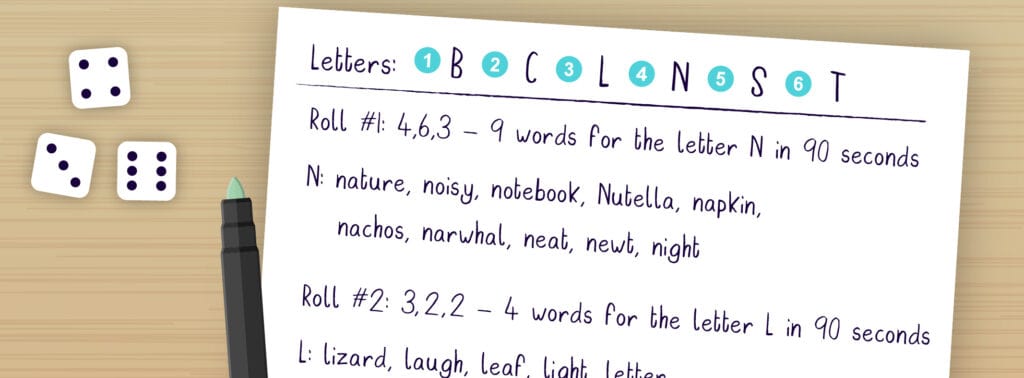
How to collect points for each round:
5️⃣ If players do come up with the outlined number of words for the specified letter in the allotted amount of time they get 5 points.
3️⃣ If they don’t get enough words, but made an effort to come up with a few they get 3 points.
0️⃣ If they don’t come up with any words they get zero points.
🏆 The first player to reach or pass 26 points – because there are 26 letters in the alphabet – wins the game!
Here’s an example:
I just played this game with my 8-year-old niece the other day and she chose the letters B, C, L, N, S, T and we numbered them 1 through 6 in alphabetical order. We decided to play using 90-second rounds.
So here’s what my niece’s first turn looked like:
1️⃣ She rolled a 4 with the first die, and that corresponded to the letter “N”.
2️⃣ Next, she rolled the other two dice and they landed on 6 and 3. She added those digits together to get 9.
3️⃣ She had 90 seconds to come up with 9 words that start with the letter “N”.
4️⃣ With 5 seconds to spare, she completed the task. Check out her answers in the example above!
5️⃣ Five points went her way for this successful round.
💡Get the whole class involved in this activity!
🏁 Start by selecting 6 letters together and having students take turns rolling the dice each round.
📝 Students will work independently each round on their own lists and read their words out loud to each other at the end of each round.
🚫 If they have the same word as another student on their list, then they cross that word off as it will not count.
1️⃣ Each student gets one point for each original word on their list.
🏆 The goal is to have the most unrepeated words, and consequently the most points.
9. Roll With the Parts of Speech
I love using this game with elementary students of all ages and skill levels to solidify their understanding of the eight parts of speech.
😀 Players: Teams of 2 players
📝 Materials: Timer, Paper, Pencil
🔢 Working: Parts of Speech, Sentence Writing, Peer Editing and Reflection
🎯 Objective: Make a complex sentence based on the words and part of speech rolled.
😎 Ages: 8 – 12 years
🎲 Dice: 3 dice for the whole group
💡If you need a refresher on the parts of speech, check out this detailed blog post we wrote about the eight parts of speech. And, you’re students will appreciate these parts of speech videos.
Have children play this game in teams of two and see how they collaborate to build complex sentences using different parts of speech.
Don’t let the word “complex” scare your students! Have them practice constructing and recognizing these types of sentences until it becomes second nature.
💡 What’s a complex sentence?
A complex sentence is a type of sentence with two parts, one of which is an independent clause and the other of which is a dependent clause.
An example of a complex sentence is, “The child stayed up to read despite the late hour.” Here, we have the main clause “the child stayed up to read,” along with the dependent clause “despite the late hour,” making it complex.
Need a refresher on complex sentences? Click here to learn more.
Before you start this activity, three Lists Need to be Made:
1️⃣ One list of 6 different verbs (examples: dance, read, shout, open, crawl, trade).
2️⃣ One list of 6 different nouns (examples: volcano, penguins, cake, skateboard, watermelon, camera).
3️⃣ One list of the 6 remaining parts of speech (adjective, adverb, pronoun, preposition, conjunction, interjection).
💡TEACHER NOTE
While some say it is, the article is not its own part of speech. The article is a special class of adjective that gives more information about a noun. Fascinating!
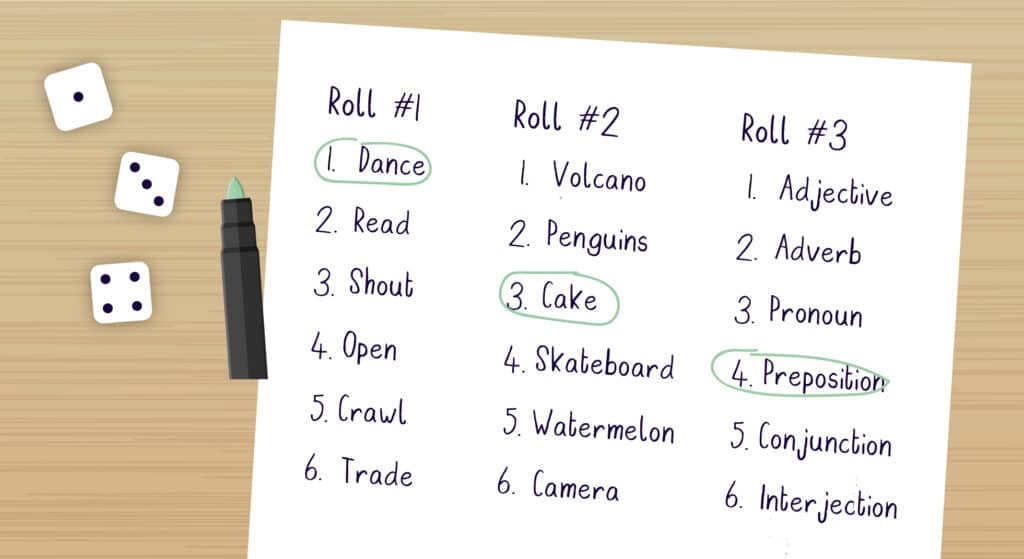
How to play:
1️⃣ Group 1 will roll all three dice one at a time and record each number rolled. Each roll of a die corresponds to a number on each list. Have students write down the words they need to use at the top of their page.
2️⃣ They will have 120 seconds (or however long you think they’ll need) to come up with a complex sentence using the words and part of speech they rolled. They can add as many other words to enhance their sentence, but it must include what they rolled and it must make sense.
3️⃣ When they are done, or the time has run out, they will read the sentence to the group.
4️⃣ The opposing team will score the sentence created. They will give one point for the proper use of each of the three words rolled and one point for the sentence being complex, so players can accumulate up to 4 points each round.
5️⃣ The play moves to the next team and they follow the same steps of rolling the dice and creating a complex sentence using the words and part of speech rolled.
🏆 The team with the most points at the end of 5 rounds wins.
The perfect supplemental activity to any study of the parts of speech.
In addition, by encouraging elementary-aged children to reflect on each other’s work, we can help them learn important skills like giving effective feedback, understanding differences in opinions, and strengthening collaboration – in a fun and engaging environment.
Ultimately, this practice gives them the foundation for interacting with colleagues throughout their academic journey, and even in their future professional endeavours!
💡Make it even more Montessori!
Have students symbolize their sentences using the Montessori Parts of Speech symbols and let them earn bonus points for correct symbolization of words in the sentence.
Stylize Your Classroom With the Parts of Speech!
Check out our adorable and educational parts of speech posters/handouts!
🐶 One with an adorable dog and another with an 🐸 awesome frog!
Perfect for brightening any learning environment or lesson.

10. Yesterday
This small group activity works well as a follow-up activity after a language lesson about verb tense. It’s also great for early finishers, ESL students, and I even use it with my students during indoor recess.
😀 Players: 3 players
📝 Materials: Paper, Pencil
🔢 Working: Verb Tense, Asking Questions
🎯 Objective: Practice the past simple form of verbs by asking questions about yesterday.
😎 Ages: 6 – 12 years
🎲 Dice: 1 die for each player
To start:
🎲 Each player will need one die.
🤔 Have players think of and write down a list of 6 actions they did the previous day.
To play:
🎲 Determine who the youngest player is because they get to go first!
🎲 The player rolls the die and reads out what they wrote for that corresponding number on their list of things they did yesterday.
🗒️ Note: While all three dice are never in play at the same time, this is still a game with three dice! So go ahead and give it a try!

Here’s an example of what the list of yesterday’s actions might look like:
Yesterday…
1. I walked my dog.
2. I went for a hike.
3. I ate watermelon.
4. I played the ukulele.
5. I built a lego dragon.
6. I read a few chapters of a book.
Using this above list, an example of gameplay is as follows:
🎲 Player one rolls the die and lands on 3.
👀 They look at the third sentence on their list.
🤓 The player reads out their third sentence, in this case, “I ate watermelon.”
💭 The other two players need to come up with a suitable question to ask for the statement, “I ate watermelon”.
😃 Player two may ask: “What did you eat for breakfast yesterday?”
😀 While player three may ask: “What did you eat for a snack yesterday?”
🤓 The student who rolled the die decides which question is the most accurate or the closest to being correct.
😀 The player who asked the correct question (or closest to the correct question) gets as many points as the spots on the face of the die. In this example that would be 3 points. The player that rolled the dice gets twice the amount of points. In this case, they would get 6 points. Nice!
🏆 The first player to 30 points wins.
🍉 And if you are curious, I ate watermelon for breakfast yesterday. The best mono-meal when living in a van camper!
You have to give this game a try with your elementary learners. They will have a blast engaging in conversation and asking each other intriguing questions.
💡Take a further step back in time!
Keep gameplay the same, but have students think about and write down a list of 6 things they did:
✳️ last week
✳️ last month
✳️ last summer
✳️ last school year
Work on their memory retention while improving their conversational skills.
💡 Discover more language activities for elementary students:
Book Report Ideas for 5th Grade that Spark Imagination
Your Guide to Starting a Family Book Club Now
Classroom Vocabulary Activities: 11 Post-Picture Book Reading Ideas
35 Money Books for Kids that Teach Financial Literacy
31 Picture Books for 5th Graders with Expert Tips for Selection
19 Powerful Reasons Why Elementary Kids Need Summer Reading Logs
31 Summer Reading Activities for Your Elementary Students
Physical Education Games with Three Dice
Games that use three dice are great for getting kids moving. They’re exciting, intriguing, and sometimes a bit wacky. Perfect for the elementary-aged child!
11. Just Roll With It
As adults who love to move our bodies, and lovers of learning and art, Karen and I created this dice game with three dice keeping all three of those things in mind.
This build-it-yourself game will bring a lot of movement but also fun, laughter, togetherness, and even a little healthy competition to the elementary-aged kids in your life.
Just Roll With It was designed for elementary students, but in reality, everyone loves playing this game!
😀 Players: 1 or 2
📝 Materials: A variety of things found around the house.
💪 Working: Coordination, Following Instructions, Stamina, Fine Motor Skills
🎯 Objective: Exercise the body with fun and crazy activities that are hilarious.
😎 Ages: 6 – 12 years
🎲 Dice: Just Roll With It OR 3 DIY game dice (download our Free dice and use the blank page to make your own!)

Students actually take part in the making of the game dice by:
🖍️ colouring the printouts;
✂️ cutting the 2D nets;
🧺 folding the 2D nets;
🏗️ building the 2D nets into 3D cubes.
As a result, they are able to explore their creative side with this activity.
Players will also (secretly) be practicing their math skills as they play. They’ll be:
⏱️ tracking time;
➕ tallying scores;
🔢 counting repetitions, and even;
📐 assessing trajectories and angles for trick shots.
There’s so much learning in disguise being had with this active dice game for kids.
Each die includes specific game-playing prompts.
🧸 One die outlines what you will use to play the game.
🧦 One die identifies how you will play the game.
🎯 One die describes the aim of the game.
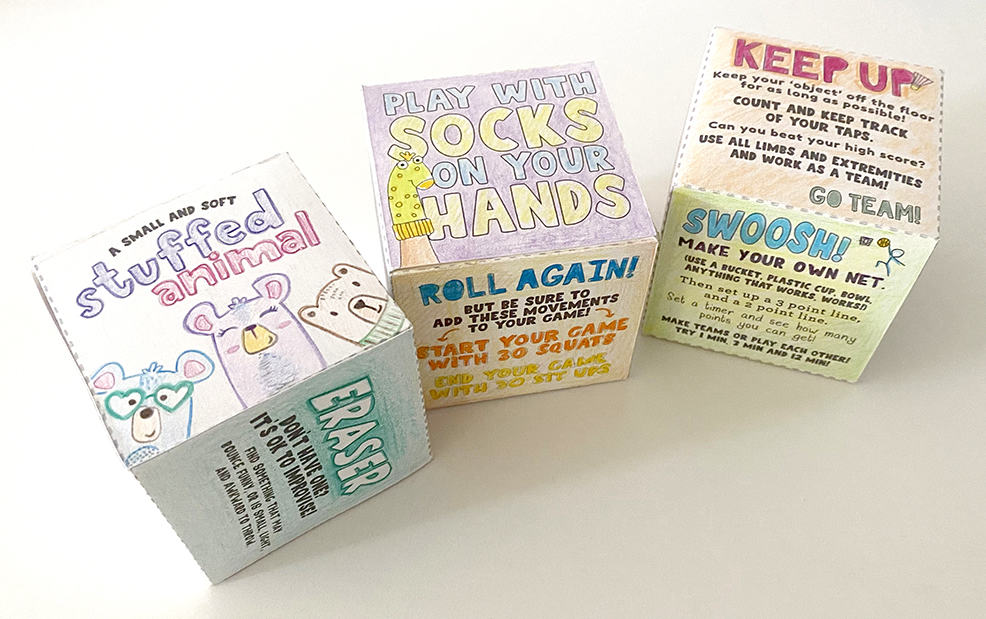
For example, this player rolled ‘a small and soft stuffed animal’, ‘play with socks on your hands’, and ‘keep up’. This player will be using their limbs to tap a stuffed animal to keep it up off the floor, all while wearing socks on their hands. Interesting!
This game is great for PE class, team-building activities, as a reading activity, and for lessons on following instructions!
You can even use Just Roll With It for early finishers or as a class incentive activity.
We’re also thinking you’ll want to introduce this game to your household, too.
It’s just that fun!
💡Team Up for More Fun!
Just Roll With It can be played in small groups, too!
Create teams of two, three, or even four.
Players will all get a chance to try the wacky movement challenges and work hard to help their team earn points.
A great activity for birthday parties and sleepovers!
12. Jump Like a Frog
In this total body workout activity, students will take turns rolling all three dice to find out what animal movement they will be doing, for how long, and how many points it’s worth.
😀 Players: 2 or more players (can also be played in small groups or teams)
📝 Materials: List of Animal Movements, List of Different Times, List of Points
💪 Working: Coordination, Following Instructions, Animal Movements, Core Strength
🎯 Objective: Perform the animal movement rolled for the duration of time rolled to get the number of points rolled.
😎 Ages: 8 – 12 years
🎲 Dice: 3 dice for the whole group
Before playing:
🐸 Come up with a list of six animal actions (ask for student input on this to make it even more interactive!) and number them one through six.
➡️ Don’t know any animal movements? We’ve included some below to help you get started.
⏱️ Now come up with a list of six different amounts of time. I like to keep mine in a range of 20 seconds to 90 seconds.
🔢 Finally, you will need a list of six different points to be rewarded for completing the rolled task.
To play:
A player rolls the three dice one at a time and consults the lists to see what movement they will need to do, for how long, and the points they’ll get for doing the task.
🦘 Roll 1: Tells players what animal they will be moving like;
⏱️ Roll 2: Determines how long the movement will go on;
🔢 Roll 3: Establishes how many points that movement is worth.
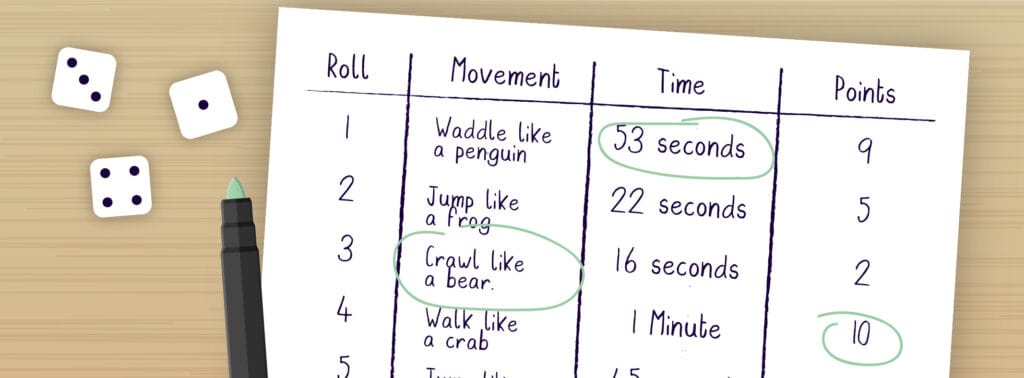
Play for a predetermined amount of time, rounds, or points. I like to play for twenty minutes – or see who can get to fifty points first.
Example of animal movements:
1. Waddle like a penguin
2. Jump like a frog
3. Crawl like a bear
4. Walk like a crab
5. Jump like a kangaroo
6. Slither like a snake
If a player rolls a 3, 1, and 4 in that order then they will be crawling like a bear (3 in the movement list) for 53 seconds (1 in the time list) and they will get 10 points (4 in the points list) if they finish the task.
Share this video with your students for animal movement inspiration:
Moving like animals is not only fun, but it carries many benefits. Children will develop strength, improve balance, and be encouraged to play creatively with this game.
This movement game is great for adults to join in on, too! We’re here to get everybody, and every body, moving!!!
💡Take It Cross-Curricular!
Have students research animals from a specific biome or country they are learning about.
Better yet, have them find out about animals they didn’t even know existed, then learn how they move in the wild.
Use these newfound animal movements to make this game aligned with what students are learning in class.
For example:
They could come up with ‘Bounding like a Kangaroo Rat (aka the Jerboa)!’ Cosmic education in action!

(aka the Jerboa).
13. Verbs on the Move
This game with three dice is a fun way to learn while also getting some exercise.
Use this movement dice game in your parts of speech-language lessons to enhance student understanding of the verb.
This activity is also great as a mid-day break or when the weather is not cooperating and the kids are stuck inside.
😀 Players: 2 or more players
📝 Materials: Paper and Pencil
💪 Working: Coordination, Following Instructions, Stamina, Fine Motor Skills
🎯 Objective: Strengthening the body with exercise while also strengthening their understanding of verbs.
😎 Ages: 8 – 12 years
🎲 Dice: 3 dice for the whole group
Before starting:
🏃 Write down six movements (actions/verbs) and number them one through six.
⏱️ Write down six increments of time and number them one through six.
🔢 Write down six repetition amounts and number them one through six.
I like to use movements such as jumping jacks, running on the spot, and hopping on one foot – you get the idea. Check out the example list below for more ideas. 👇
To play:
🎲 Players take turns rolling all three dice. On their turn, they will roll one die at a time.
💥 The first dice: Represents the movement that the player will do.
⏱️ The second dice: Represents the amount of time they will spend doing the movement
🔢 The third dice: Represents how many times they have to repeat the movement.
As a fun plot twist:
🎲 Players get to choose to use the second dice or the third dice. That’s right, they only have to do one of them – either an amount of time or a number of repetitions.
Yay for the freedom to make choices! That’s so Montessori.
Here’s a list of movements to start with, we’ve included video references for you!
1. Mountain Climbers
2. Jumping Jacks
3. Running on the Spot
4. Hop Back and Forth (or side to side!)
5. Squats
6. Burpees
8. High Knees
For example:
Let’s say a player rolls a 3 and it corresponds to running on the spot. If their second roll is a 5 it would correspond to 50 seconds and if their third roll is a 1 that corresponds to 60 repetitions.
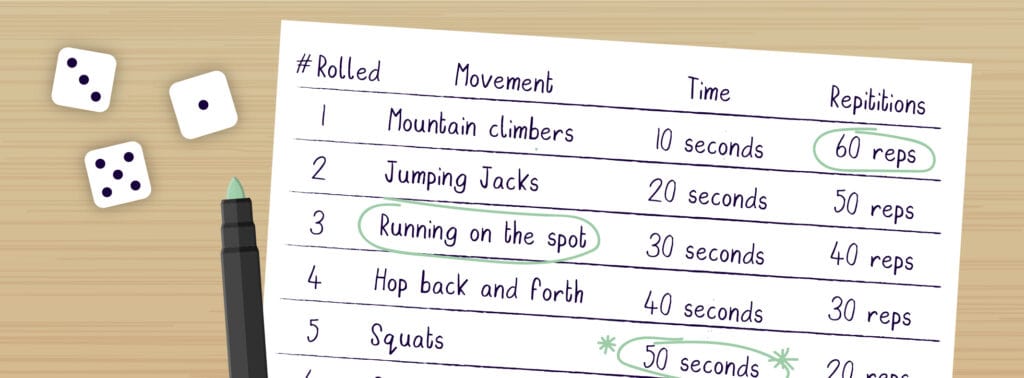
Players will find themselves deeply contemplating their options to see which would be more efficient or which one makes sense. They are working many muscles in this movement activity!
Want to show your students how to do these movements properly? Check out these great videos:
💡Compare and Contrast!
Do you have strong, eager students among you? Any aspiring athletes?
Get them to complete both tasks!
Have participants complete the movement with the rolled amount of time, take a short break, and then complete the task for the number of repetitions rolled. Which one was more challenging?
I feel some teachable moments popping up here!
14. Dice Workout
Encourage children to exercise and stay active with this fun dice workout game.
Players take turns rolling all three dice and performing the bodyweight exercises corresponding to the numbers rolled.
They have to complete each exercise rolled for 30 seconds and keep track of how many times they do each movement.
After all three exercises have been completed, the player adds all 3 exercise repetitions completed together. That’s their score for that 90-second round of hard work.
Then play moves to the next player.
😀 Players: 2 or more players (can be played in two small groups or pairs)
📝 Materials: A list of 6 exercises, Timer, Paper, and Pencil
💪 Working: Following Instructions, Stamina, Building Strength
🎯 Objective: Complete as many repetitions as possible of 30 seconds of 3 different exercises.
😎 Ages: 8 – 12 years
🎲 Dice: 3 dice for the whole group
Here are some example bodyweight exercises that are great for kids and that do not take up too much space:
1. Lunges
2. Mountain Climbers
3. Squats
4. Push-Ups (Can also be done on knees or against a wall!)
5. Sit-Ups
6. Crab Walk
Want to show your students how to do these movements properly? Check out these great videos:
Other movements we suggest are: burpees, step-ups, calf-raises, crab walks, inch worms, leg raises. . .anything that they can count repetitions of!
This workout activity continues for a predetermined amount of time. I like to start with ten minutes and work my students up to 20 or 30 minutes of exercise at least two times each week.
The player with the largest repetition sum wins!
For example:
If a player rolls a 2, 4, and 6 then they will be completing 30 seconds of mountain climbers, then 30 seconds of push-ups, and finally 30 seconds of box jumps for their turn.
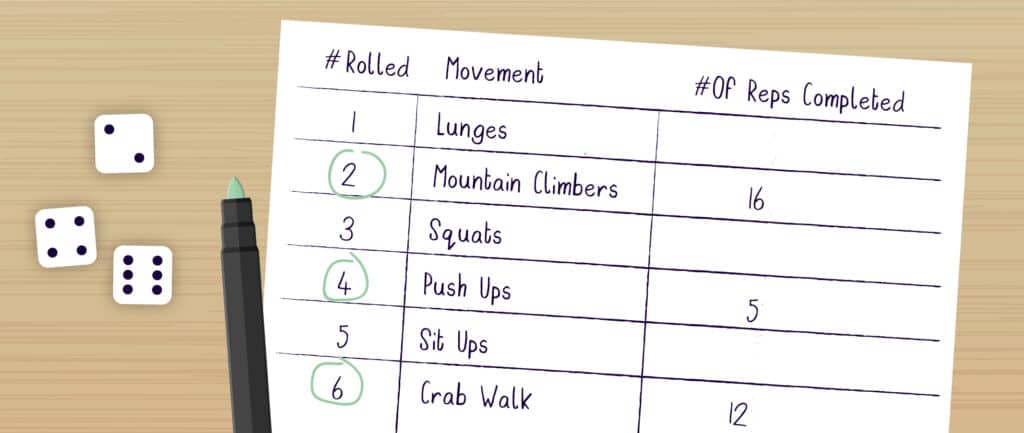
After each 30s of work, the player will write down the number of repetitions they completed of the exercise. If they completed 16 mountain climbers in 30 seconds then they will write that down, along with the 5 push-ups and the 12 crab walks.
After completing their 90 seconds of work, they will add their repetitions together. In this case, it would be 16 + 5 + 12 for a total of 33. Nice score!
Players will be feeling the burn after a few rounds of movement with this game!
Daily physical activity is beneficial for all students, especially those who crave movement. Moderate to vigorous physical activity breaks throughout the school day promote the growth and development of the child.
This activity will definitely get their heart rates up as well as their appreciation for all the physical activity they can do in 90 seconds!
💡May we suggest you join in on the fun?
Lead by example and show that everyone benefits from adding some movement to their day. Everyone will benefit from your participation. That’s so Montessori!
15. Double Trouble
This game of chance will keep players on their toes (actually) and get their blood flowing.
😀 Players: 8 or more players
📝 Materials: Timer
🔢 Working: Number Recognition, Stamina, Building Strength
🎯 Objective: Avoid rolling doubles.
😎 Ages: 8 – 12 years
🎲 Dice: 3 dice for the whole group
How to play:
1️⃣ Decide who will go first and the direction in which the play will continue.
🏃 With all participants standing in a circle surrounding three dice, everyone jogs (or walks) on the spot. Everyone keeps moving the whole time!
🎲 On their turn, players run into the middle of the circle and roll all three dice. If no doubles are rolled, they run back to their spot in the circle, continue jogging on the spot with everyone else, and the next player runs to the middle to roll all three dice.
🎲🎲 🏋️♂️ If a player rolls doubles, all participants have to complete 30 seconds of bodyweight air squats (or a movement you want them to work on) before that player runs back to their spot.
⏱️ Play for a predetermined amount of time or until all players have had the chance to roll the dice in the middle of the circle.
No matter the length of play, the health benefits are going to stay!
💡Make this game even more of a challenge!
Ask the class to come up with 6 different exercise movements, and number them 1-6.
When doubles are rolled, that number corresponds to the movement the entire group will do for 30 seconds.
But if triples are rolled, everyone has to do 10 burpees.
Sounds fun, right?
Why I Love Games with Three Dice for Kids
Games with three dice tend to have more rules and can be a bit more challenging than those that use just one or two dice. This can make them more exciting for elementary-aged kids as they try to figure out the best way to be successful in the game.
I love using activities to supplement a broad range of subjects, such as math, language, and physical education. Cross-curricular learning is made possible with games using three dice. How about that!
And let’s be real, elementary-aged children just find it fun to throw a whole lot of dice around. Or better put, they are eager to get their hands on all that learning. That’s so Montessori!
💡Cross-curricular learning is very common in the Montessori Classroom. Read about how the Montessori classroom is different from traditional education in this article.
Benefits of Playing Dice Games With Kids
Who knew learning could be all fun and games with the roll of some dice?
Playing games with three dice can do more than just provide an entertaining break from students’ studies – it can help develop an array of important skills that kids can take from the classroom and use in everyday life.
💡Dice games have benefits! For elemntary-aged chidlren they:
🎲 teach kids about number sense, problem-solving, strategy skills, creative writing, and even the importance of physical fitness;
🎲 provide imaginative playtime;
🎲 connect students with what they are learning in a deeper way;
🎲 cultivate important lessons about strategy and logical thinking;
🎲 are great for developing patience, collaboration, and social skills;
🎲 build concentration and promote resilience as they learn from mistakes;
🎲 are exciting and challenging which results in increased confidence in kids.
This is your sign to pick up three dice and get the learning rolling today. You won’t regret it!
Dice Games Increase Confidence in Kids
When playing dice games, kids are able to improve their confidence in a number of ways.
🎲 They learn how to take risks and try new things.
This is especially important when it comes to trying out new vocabulary words and math strategies. Games provide a safe space where kids can explore and test their abilities. My students are comfortable putting themselves out there when there is fun involved because that feeling of fun overrides the fact that they are learning making them very interested in the task at hand.
😄 Children learn how to have fun while learning.
Games with three dice are a great way to combine learning with play. This helps kids to stay engaged, motivated, and interested in participating in the act of learning because it’s fun. My students don’t even realize it, but they are learning in disguise when they are playing educational dice games. As a result, they’re also increasing their knowledge base as well as confidence in that subject area.

🥇 Games with dice help kids feel successful.
When they are able to participate with their peers and complete a game – or even just come really close to winning – they feel a sense of accomplishment that can boost their confidence in other areas of their lives. When the dice come out in my classroom, so do the smiles! Kids look forward to the feelings of success that come with playing.
🤔 Dice games help kids think differently and look at different perspectives.
This is important for kids as it teaches them how to think through a problem and find a solution. Games require players to think deeply and make confident choices. As an educator, I love to implement games like this because they help students look at a situation from every possible angle and literally just roll with it. This always opens up fascinating conversations in class between students who are of varying ages and skill levels.
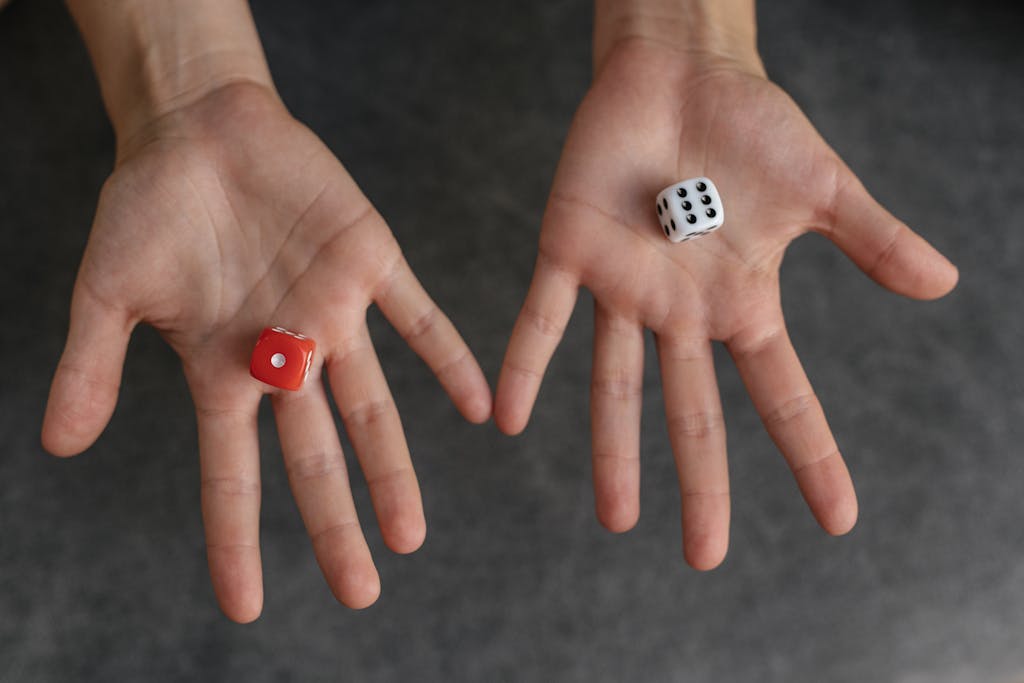
You heard it here first! Playing games with three dice helps foster an environment of learning and social development that builds confident kids.
Don’t Have 3 Dice?
No problem! We’ve got you covered.
If you’re looking for a fun way to bring dice games into your learning environment then you need to get a copy of our printable emoji dice. They are perfect for any elementary classroom because students take part in the building of the dice and really make them their own.
These free DIY dice are an easy, cost-effective solution that will bring smiles to your students’ faces. Whether it’s a writing activity, math challenge, or movement activity, these dice can help make learning more engaging and fun.
Get rolling and brighten up your students’ day with our emoji dice!
The Wrap-Up: Include Games With Three Dice in Your Classroom!
Games with three dice are a fun way to build essential skills for elementary kids. They can help with math, language, and even physical fitness.
So break out the dice and get rolling! Your elementary learners will benefit in many ways from all the fun and learning.
Keep your elementary students busy having fun learning!
Check out these articles we wrote:
21 Fun Math Games with Dice to Try With Kids 8-12
9 Montessori-Aligned Math Activities for Elementary Students
13 Vocabulary Development Activities for the Elementary Level
Rebus Puzzles for Kids: A Comprehensive Riddle-Solving Guide


